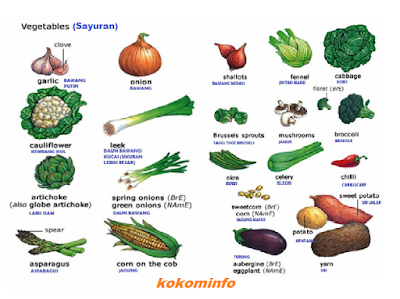Hai semuanya ....
Kali ini kakak akan berbagi artikel tentang macam-macam nama sayuran dalam bahasa Inggris beserta dengan penjelasan singkatnya. Silahkan simak artikelnya di bawah ini.
Macam-Macam Nama Sayuran dalam
Bahasa Inggris dan Penjelasannya
1. Leek (Daun Bawang)
The leek is a vegetable, a cultivar of Allium ampeloprasum, the broadleaf wild leek. The edible part of the plant is a bundle of leaf sheaths that is sometimes erroneously called a stem or stalk. Historically, many scientific names were used for leeks, but they are now all treated as cultivars of A. ampeloprasum. The name 'leek' developed from the Anglo-Saxon word leac. Two closely related vegetables, elephant garlic and kurrat, are also cultivars of A. ampeloprasum, although different in their uses as food. The onion and garlic are also related, being other species of the genus Allium.
2. Cauliflower (Kembang Kol)
Cauliflower is one of several vegetables in the species Brassica oleracea in the genus Brassica, which is in the family Brassicaceae. It is an annual plant that reproduces by seed. Typically, only the head is eaten – the edible white flesh sometimes called "curd" (similar appearance to cheese curd). The cauliflower head is composed of a white inflorescence meristem. Cauliflower heads resemble those in broccoli, which differs in having flower buds as the edible portion. Brassica oleracea also includes broccoli, brussels sprouts, cabbage, collard greens, and kale, collectively called "cole" crops, though they are of different cultivar groups.
3. Garlic (Bawang Putih)
Garlic (scientific name Allium sativum) is a species in the onion genus, Allium. Its close relatives include the onion, shallot, leek, chive, and Allium chinense. With a history of several thousand years of human consumption and use, garlic is native to the region between the Mediterranean and China, and has long been a common seasoning worldwide. It was known to Ancient Egyptians, and has been used both as a food flavoring and as a traditional medicine.
4. Celery (Seledri)
Celery (Apium graveolens), a marshland plant in the family Apiaceae, has been cultivated as a vegetable since antiquity. Celery has a long fibrous stalk tapering into leaves. Depending on location and cultivar, either its stalks, leaves, or hypocotyl are eaten and used in cooking. Celery seed is also used as a spice; its extracts are used in medicines.
5. Broccoli (Brokoli)
Broccoli is an edible green plant in the cabbage family whose large flowering head is eaten as a vegetable. The word broccoli comes from the Italian plural of broccolo, which means "the flowering crest of a cabbage", and is the diminutive form of brocco, meaning "small nail" or "sprout". Broccoli is often boiled or steamed but may be eaten raw.Broccoli is classified in the Italica cultivar group of the species Brassica oleracea. Broccoli has large flower heads, usually green in color, arranged in a tree-like structure branching out from a thick, edible stalk.
6. Mushrooms (Jamur)
A mushroom (or toadstool) is the fleshy, spore-bearing fruiting body of a fungus, typically produced above ground on soil or on its food source. The standard for the name "mushroom" is the cultivated white button mushroom, Agaricus bisporus; hence the word "mushroom" is most often applied to those fungi (Basidiomycota, Agaricomycetes) that have a stem (stipe), a cap (pileus), and gills (lamellae, sing. lamella) on the underside of the cap. These gills produce microscopic spores that help the fungus spread across the ground or its occupant surface.
Untuk memudahkan kalian menyalin ulang artikel ini, silahkan download file MS. Wordnya di sini Nama-Nama Sayuran dalam Bahasa Inggris dan Penjelasannya.
Demikianlah info kesehatannya, semoga bermanfaat buat kita semua. Terima kasih sudah mampir di sini. Tetap Semangat dan Selalu Jaga Kesehatan :)
Sumber :
en.wikipedia.org
Artikel Pilihan
 Buah Pepaya mengandung banyak sekali nutrisi, bahkan sangat kaya akan vitamin C. Satu buah pepaya setidaknya mengandung 235 mg vitamin C.
Buah Pepaya mengandung banyak sekali nutrisi, bahkan sangat kaya akan vitamin C. Satu buah pepaya setidaknya mengandung 235 mg vitamin C.






This comment has been removed by the author.
ReplyDelete